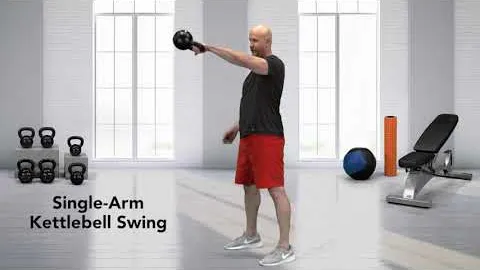The Single-Arm Kettlebell Swing: A Dynamic Full-Body Exercise for Strength and Power
The single-arm kettlebell swing is a powerful and versatile exercise that targets multiple muscle groups, improves strength and power, and enhances overall athletic performance. Whether you are an athlete, a fitness enthusiast, or just someone looking to add a dynamic and effective exercise to your routine, the single-arm kettlebell swing is a great choice. In this article, we will discuss the proper technique, benefits, variations, and safety considerations of the single-arm kettlebell swing.
Technique
To perform the single-arm kettlebell swing, follow these steps:
- Set your stance: Stand with your feet slightly wider than shoulder-width apart, toes pointed slightly outward.
- Grasp the kettlebell: Place the kettlebell on the floor between your feet. Reach down and grip the handle with one hand, palm facing your body.
- Brace your core: Engage your abdominal muscles and maintain a straight back throughout the movement.
- Hinge at the hips: Push your hips back and bend your knees slightly, as if you were preparing to sit back into a chair. Keep your chest up and your gaze forward.
- Drive through your hips: Explosively extend your hips forward, using the power generated from your glutes and hamstrings to propel the kettlebell forward and upward.
- Maintain a neutral wrist: As you swing the kettlebell, keep your wrist in a neutral position to prevent any unnecessary strain.
- Control the descent: As the kettlebell reaches its peak, allow it to swing back down between your legs. Maintain control and stability throughout the movement.
- Repeat: Continue swinging the kettlebell for the desired number of repetitions before switching to the other arm.
Benefits
The single-arm kettlebell swing offers a wide range of benefits for individuals of all fitness levels. Here are some of the advantages of incorporating this exercise into your routine:
- Full-body workout: The single-arm kettlebell swing engages multiple muscle groups, including the hips, glutes, hamstrings, core, shoulders, and back. By targeting these muscle groups, the exercise helps improve overall strength, power, and coordination.
- Improved functional movements: The explosive movement pattern mimics real-life activities, such as lifting objects from the ground or participating in sports. Regular practice of the single-arm kettlebell swing can enhance your ability to perform everyday tasks and athletic movements more efficiently.
- Increased calorie burn: As a dynamic exercise, the single-arm kettlebell swing elevates your heart rate and helps burn a significant number of calories. It can be a valuable addition to any weight loss or fat-burning program.
- Enhanced muscle definition: The single-arm kettlebell swing targets the muscles of the posterior chain, including the glutes, hamstrings, and lower back. Regular practice of this exercise can help sculpt and tone these muscle groups, leading to improved muscle definition and a more aesthetically pleasing physique.
- Improved grip strength: The grip required for the single-arm kettlebell swing challenges the muscles of the forearms and hands, leading to increased grip strength. This can have carryover benefits in various activities, such as weightlifting, rock climbing, or even day-to-day tasks that require a stronger grip.
- Time-efficient workout: The single-arm kettlebell swing provides a high-intensity workout in a short amount of time. By engaging multiple muscle groups simultaneously, it allows you to achieve a challenging full-body workout in just a few minutes.
Variations
While the traditional single-arm kettlebell swing is highly effective on its own, there are several variations that you can incorporate to add variety and further challenge your body. Here are some popular variations of the exercise:
- Double-arm kettlebell swing: Perform the swing using both hands, gripping the kettlebell handle with both palms facing inward. This variation increases the load on the muscles, providing an even greater strength and power workout.
- Alternating arm kettlebell swing: Alternate between swinging the kettlebell with your left and right arms, one at a time. This variation helps improve coordination and balance while working each arm individually.
- Deep squat kettlebell swing: Incorporate a deep squat at the bottom of the swing by bending your knees more, engaging your quads, and glutes. This variation strengthens the lower body and adds an extra challenge to the exercise.
- One-handed high pull: Instead of swinging the kettlebell forward and upward, pull it up to shoulder height, keeping your elbow close to your body. This variation targets the upper back and shoulders, adding an additional element of strength training to the exercise.
Safety Considerations
While the single-arm kettlebell swing is generally a safe and effective exercise, it is important to follow proper technique and consider the following safety tips:
- Start with a suitable weight: Begin with a kettlebell weight that allows you to perform the exercise with proper form. Gradually increase the weight as your strength and proficiency improve.
- Maintain core stability and neutral spine: A strong core and proper spinal alignment are crucial for performing the single-arm kettlebell swing safely. Engage your core muscles and avoid rounding or arching your back during the movement.
- Maintain control throughout the motion: Avoid using excessive momentum or swinging the kettlebell too far overhead, as this can put unnecessary stress on your shoulder joints. Maintain control and a smooth rhythm throughout the exercise.
- Warm up properly: Prior to performing the single-arm kettlebell swing, warm up your entire body with dynamic exercises such as jumping jacks, leg swings, and shoulder circles.
- Listen to your body: If you experience any pain or discomfort while performing the exercise, stop immediately and seek guidance from a qualified fitness professional.
In conclusion, the single-arm kettlebell swing is a highly effective exercise that offers numerous benefits for strength, power, and overall athletic performance. By incorporating this exercise into your routine, you can experience increased muscle strength, improved functional movements, and enhanced calorie burn. Remember to follow proper technique, explore variations, and prioritize safety to maximize the benefits of this dynamic full-body exercise.

